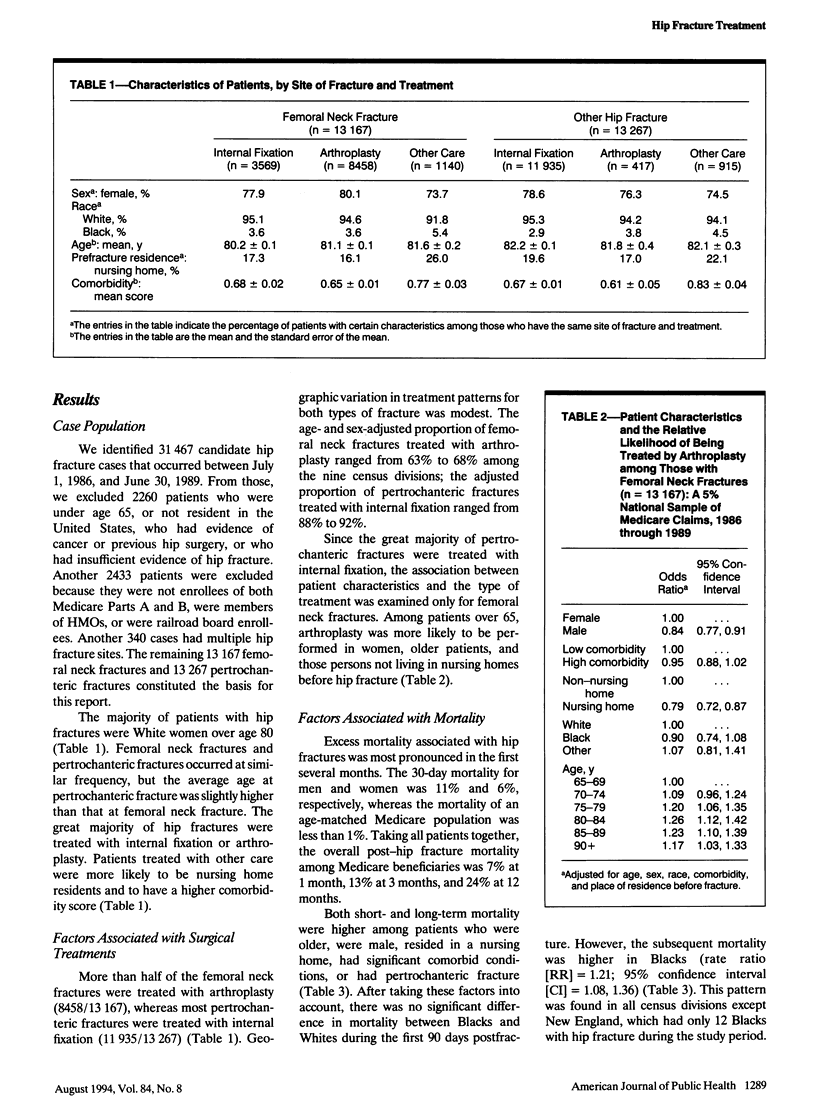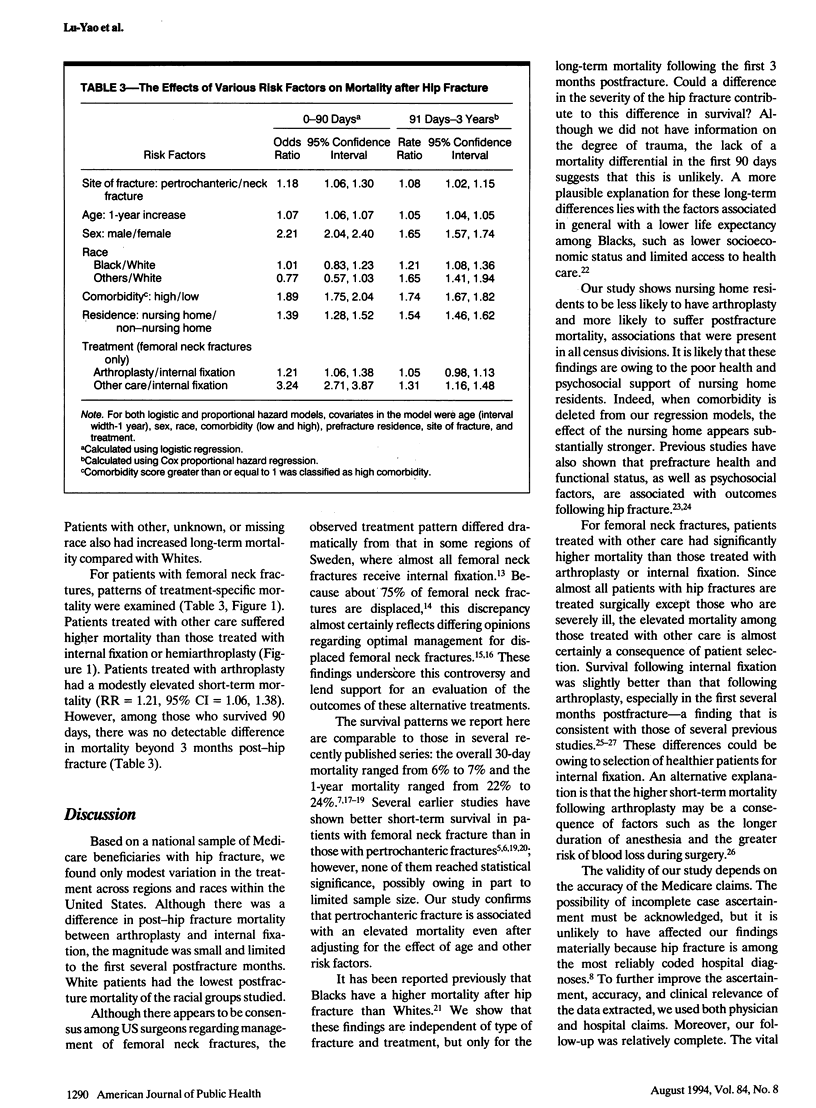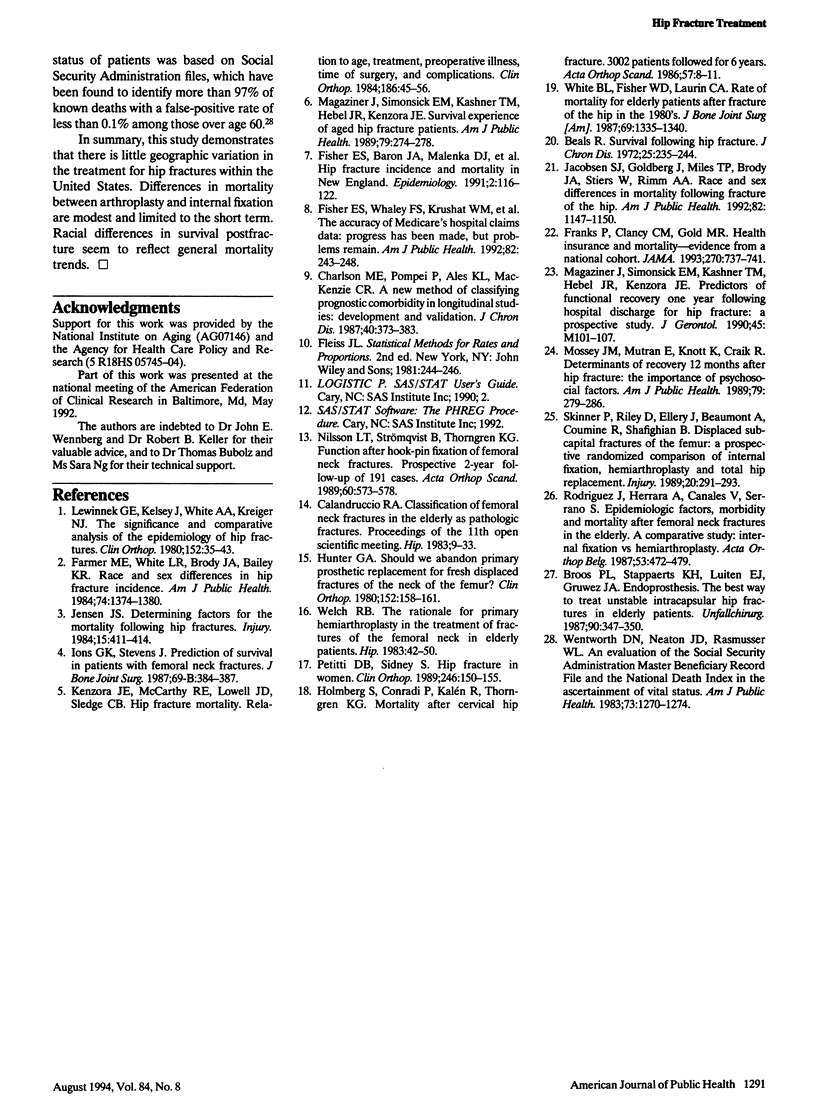Abstract
OBJECTIVES. This study was undertaken to examine the patterns of treatment and survival among elderly Americans with hip fracture. METHODS. A 5% national sample of Medicare claims was used to identify patients who sustained hip fractures between 1986 and 1989. In comparing treatment patterns across regions, direct standardization was used to derive age- and race-adjusted percentages. Logistic regression and Cox regression were used to examine short- and long-term survival. RESULTS. In the United States, 64% of femoral neck fractures were treated with arthroplasty; 90% of pertrochanteric fractures were treated with internal fixation. Higher short- and long-term mortality was associated with being male, being older, residing in a nursing home prior to fracture, having a higher comorbidity score, and having a pertrochanteric fracture. Blacks and Whites had similar 90-day postfracture mortality, but Blacks had a higher mortality later on. For femoral neck fracture, internal fixation has a modestly lower short-term mortality associated with it than arthroplasty has. CONCLUSION. Variation in the treatment of hip fracture was modest, The increased delayed mortality after hip fracture among Blacks requires further study.
Full text
PDF




Selected References
These references are in PubMed. This may not be the complete list of references from this article.
- Beals R. K. Survival following hip fracture. Long follow-up of 607 patients. J Chronic Dis. 1972 Apr;25(4):235–244. doi: 10.1016/0021-9681(72)90134-8. [DOI] [PubMed] [Google Scholar]
- Broos P. L., Stappaerts K. H., Luiten E. J., Gruwez J. A. Endoprosthesis. The best way to treat unstable intracapsular hip fractures in elderly patients. Unfallchirurg. 1987 Jul;90(7):347–350. [PubMed] [Google Scholar]
- Calandruccio R. A. Classification of femoral neck fractures in the elderly as pathologic fractures. Hip. 1983:9–33. [PubMed] [Google Scholar]
- Charlson M. E., Pompei P., Ales K. L., MacKenzie C. R. A new method of classifying prognostic comorbidity in longitudinal studies: development and validation. J Chronic Dis. 1987;40(5):373–383. doi: 10.1016/0021-9681(87)90171-8. [DOI] [PubMed] [Google Scholar]
- Farmer M. E., White L. R., Brody J. A., Bailey K. R. Race and sex differences in hip fracture incidence. Am J Public Health. 1984 Dec;74(12):1374–1380. doi: 10.2105/ajph.74.12.1374. [DOI] [PMC free article] [PubMed] [Google Scholar]
- Fisher E. S., Baron J. A., Malenka D. J., Barrett J. A., Kniffin W. D., Whaley F. S., Bubolz T. A. Hip fracture incidence and mortality in New England. Epidemiology. 1991 Mar;2(2):116–122. doi: 10.1097/00001648-199103000-00005. [DOI] [PubMed] [Google Scholar]
- Fisher E. S., Whaley F. S., Krushat W. M., Malenka D. J., Fleming C., Baron J. A., Hsia D. C. The accuracy of Medicare's hospital claims data: progress has been made, but problems remain. Am J Public Health. 1992 Feb;82(2):243–248. doi: 10.2105/ajph.82.2.243. [DOI] [PMC free article] [PubMed] [Google Scholar]
- Franks P., Clancy C. M., Gold M. R. Health insurance and mortality. Evidence from a national cohort. JAMA. 1993 Aug 11;270(6):737–741. [PubMed] [Google Scholar]
- Holmberg S., Conradi P., Kalén R., Thorngren K. G. Mortality after cervical hip fracture. 3002 patients followed for 6 years. Acta Orthop Scand. 1986 Feb;57(1):8–11. doi: 10.3109/17453678608993205. [DOI] [PubMed] [Google Scholar]
- Hunter G. A. Should we abandon primary prosthetic replacement for fresh displaced fractures of the neck of the femur? Clin Orthop Relat Res. 1980 Oct;(152):158–161. [PubMed] [Google Scholar]
- Ions G. K., Stevens J. Prediction of survival in patients with femoral neck fractures. J Bone Joint Surg Br. 1987 May;69(3):384–387. doi: 10.1302/0301-620X.69B3.3584189. [DOI] [PubMed] [Google Scholar]
- Jacobsen S. J., Goldberg J., Miles T. P., Brody J. A., Stiers W., Rimm A. A. Race and sex differences in mortality following fracture of the hip. Am J Public Health. 1992 Aug;82(8):1147–1150. doi: 10.2105/ajph.82.8.1147. [DOI] [PMC free article] [PubMed] [Google Scholar]
- Jensen J. S. Determining factors for the mortality following hip fractures. Injury. 1984 May;15(6):411–414. doi: 10.1016/0020-1383(84)90209-2. [DOI] [PubMed] [Google Scholar]
- Kenzora J. E., McCarthy R. E., Lowell J. D., Sledge C. B. Hip fracture mortality. Relation to age, treatment, preoperative illness, time of surgery, and complications. Clin Orthop Relat Res. 1984 Jun;(186):45–56. [PubMed] [Google Scholar]
- Lewinnek G. E., Kelsey J., White A. A., 3rd, Kreiger N. J. The significance and a comparative analysis of the epidemiology of hip fractures. Clin Orthop Relat Res. 1980 Oct;(152):35–43. [PubMed] [Google Scholar]
- Magaziner J., Simonsick E. M., Kashner T. M., Hebel J. R., Kenzora J. E. Predictors of functional recovery one year following hospital discharge for hip fracture: a prospective study. J Gerontol. 1990 May;45(3):M101–M107. doi: 10.1093/geronj/45.3.m101. [DOI] [PubMed] [Google Scholar]
- Magaziner J., Simonsick E. M., Kashner T. M., Hebel J. R., Kenzora J. E. Survival experience of aged hip fracture patients. Am J Public Health. 1989 Mar;79(3):274–278. doi: 10.2105/ajph.79.3.274. [DOI] [PMC free article] [PubMed] [Google Scholar]
- Mossey J. M., Mutran E., Knott K., Craik R. Determinants of recovery 12 months after hip fracture: the importance of psychosocial factors. Am J Public Health. 1989 Mar;79(3):279–286. doi: 10.2105/ajph.79.3.279. [DOI] [PMC free article] [PubMed] [Google Scholar]
- Nilsson L. T., Strömqvist B., Thorngren K. G. Function after hook-pin fixation of femoral neck fractures. Prospective 2-year follow-up of 191 cases. Acta Orthop Scand. 1989 Oct;60(5):573–578. doi: 10.3109/17453678909150125. [DOI] [PubMed] [Google Scholar]
- Petitti D. B., Sidney S. Hip fracture in women. Incidence, in-hospital mortality, and five-year survival probabilities in members of a prepaid health plan. Clin Orthop Relat Res. 1989 Sep;(246):150–155. [PubMed] [Google Scholar]
- Rodriguez J., Herrara A., Canales V., Serrano S. Epidemiologic factors, morbidity and mortality after femoral neck fractures in the elderly. A comparative study: internal fixation vs. hemiarthroplasty. Acta Orthop Belg. 1987;53(4):472–479. [PubMed] [Google Scholar]
- Skinner P., Riley D., Ellery J., Beaumont A., Coumine R., Shafighian B. Displaced subcapital fractures of the femur: a prospective randomized comparison of internal fixation, hemiarthroplasty and total hip replacement. Injury. 1989 Sep;20(5):291–293. doi: 10.1016/0020-1383(89)90171-x. [DOI] [PubMed] [Google Scholar]
- Welch R. B. The rationale for primary hemiarthroplasty in the treatment of fractures of the femoral neck in elderly patients. Hip. 1983:42–50. [PubMed] [Google Scholar]
- Wentworth D. N., Neaton J. D., Rasmussen W. L. An evaluation of the Social Security Administration master beneficiary record file and the National Death Index in the ascertainment of vital status. Am J Public Health. 1983 Nov;73(11):1270–1274. doi: 10.2105/ajph.73.11.1270. [DOI] [PMC free article] [PubMed] [Google Scholar]
- White B. L., Fisher W. D., Laurin C. A. Rate of mortality for elderly patients after fracture of the hip in the 1980's. J Bone Joint Surg Am. 1987 Dec;69(9):1335–1340. [PubMed] [Google Scholar]


